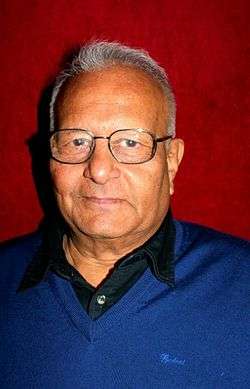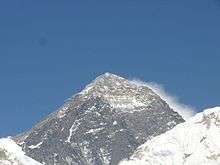Harish Kapadia
| Harish Kapadia | |
|---|---|
|
Harish Kapadia Explorer and Mountaineer | |
| Born |
11 July 1945 Mumbai, India |
| Spouse(s) | Geeta Kapadia |
| Children |
Sonam Kapadia (son) (Deceased) Lt. Nawang Kapadia (son) |
Harish Kapadia (Born 11 July 1945) is a distinguished Himalayan Mountaineer, author and long-time editor of Himalayan Journal from India.[1] He has been awarded the Patron's Medal of the Royal Geographic Society,[2] and the Life Time Achievement Award for Adventure by the President of India and the King Albert Mountain Award presented by The King Albert I Memorial Foundation. He has written numerous books and articles on the Indian Himalaya.[3]
Biography
He began climbing and trekking in the range around Bombay, the Western Ghats. His first visit to the Himalaya was almost 40 years ago. His main contribution to Himalayan climbing has been to explore unknown areas and, in number of cases, to open up climbing possibilities. Some of his major ascents have been of Devtoli (6788 m), Bandarpunch West (6102 m), Parilungbi (6166 m), in 1995, Lungser Kangri (6666 m) the highest peak of Rupshu in Ladakh. He led eight international joint expeditions,[1][2] five with the British, two with the French and one with the Japanese mountaineers,[2] to high peaks, such as Rimo I (7385 m), Chong Kumdan Kangri I (7071 m), Sudarshan Parvat, Padmanabh (7030 m), and the Panch Chuli and Rangrik Rang groups.[2]
Earlier, in 1974 he fell in a crevasse at 6200 m, deep inside the formidable Nanda Devi Sanctuary.[1] He was carried by his companions for 13 days to the base camp where a helicopter rescued him. He was operated for a dislocated hip-joint and had to spend two years walking on crutches. But that did not keep him out for too long and he has climbed for three decades after the injury.
Kapadia has a degree in Commerce, Law and Management from Bombay University and he is a cloth merchant by profession. He has published twelve books. His Trek The Sahyadris has now become a standard reference for all trekkers in the Western Ghats. His other books, Exploring the Hidden Himalaya (with Soli Mehta) and High Himalaya Unknown Valleys and Meeting The Mountains cover his various trips to the Himalaya, while Spiti Adventures in the Trans-Himalaya, covers climbing and trekking in that region. He has been the editor of the Himalayan Journal for the past 28 years, bringing the journal to international standards and continuing it as a major authentic reference on the range.
Kapadia has been elected an Honorary Member of the (British) Alpine Club. He was a Vice President of the Indian Mountaineering Foundation (1997–1999). He was awarded the Indian Mountaineering Foundation (IMF) Gold Medal by the Indian Mountaineering Foundation in 1993.[4] In 2003, the Queen approved the award of the Patron's Gold Medal of the Royal Geographical Society to him. He has been invited to many countries to lecture on his Himalayan exploits, and is a member of several organisations. He is married, and lives in Bombay.
His son Lieutenant Nawang Kapadia, who was commissioned on 2 September 2000 in the Fourth Battalion the Third Gorkha Rifles,[5] died while fighting Pakistan based terrorists in the jungles of Rajwar in Kupwara district of Srinagar on 11 November 2000.[6] Since then Harish Kapadia has taken to lecturing about this conflict, particularly in the Siachen Glacier. He has been discussing a proposal for a peace park in the Siachen glacier region and cleaning up the environmental damage there.[1][3][7]
Harish Kapadia has donated a substantial number of photographs and maps to the American Alpine Club and to the Swiss National Museum, which are setting up the Lt. Nawang Kapadia Collection. This is in addition to the Lt. Nawang Kapadia Library already in existence at the Himalayan Club.
His book, "Meeting The Mountains" is also seen while standing in line at Disney's Animal Kingdom for Expedition Everest. While passing through the line you pass through many glass cases displaying the history of mountains and at one point, you come across something that is supposed to look like an office and his book can be seen on the top bookshelf of this section.
Due his long work as editor of the Himalayan Journal, Kapadia became an important chronicler of mountaineering.[8]
Notable Climbs
Total: Peaks climbed: 33, * First Ascents 21
- Jatropani (4071m)
- Ikulari (6059m)
- Bethartoli Himal South (6318m) (Garhwal)
- Shiti Dhar (5290m)(H.P.)
- Devtoli* (6788m)[2]
- Kalabaland Dhura* (6105m)
- Koteshwar II* (5690m)(Garhwal)
- Yada (4115 m),
- Jalsu (4298 m) (H.P.)
- Lagma* (5761m),
- Zumto* (c.5800m)
- Tserip* (c.5980m)
- Kawu* (c.5910m) (Spiti)
- Kalanag(6387m)
- Bandarpunch West* (6102m) (Garhwal)[2]
- Parilungbi (6166m)[2]
- Runse* (6175m)
- Gyadung* (6160m)
- Geling* (c. 6100m)
- Lama Kyent* (c.6040m)
- Labrang* (c.5900m)(Spiti)
- Nandi* (5795m)(Garhwal)
- Laknis* (6235m)
- Chogam (6250m)
- Skyang (5770m) (East Karakoram)
- Panchali Chuli* (5220m)
- Draupadi* (5250m)(Kumaon)
- Khamengar (5760m)(Spiti)
- Mangla* (5800m)
- Kunda*(5240m)(Kinnaur)
- Lungser Kangri* (6666 m)[2][9]
- Chhamser Kangri(6622m) (Ladakh)
- Bhagat Peak* (5650m) (Garhwal)
Exploration
Bibliography
- Exploring the Hidden Himalaya
- Trek the Sahyadris
- High Himalaya Unknown Valleys
- Spiti Adventures in the Trans-Himalaya
- Meeting The Mountains
- Across Peaks and Passes in Kumaun
- Across Peaks and Passes in Garhwal
- Across Peaks and Passes in Himachal Pradesh
- Across Peaks and Passes in Ladakh, Zanskar and East Karakoram
- Across Peaks and Passes in Darjeeling and Sikkim Himalaya
- A Passage to Himalaya (editor)
- Trekking and Climbing in Indian Himalaya
References
- 1 2 3 4 "Himalayan climber to give lecture". The Irish Times. 24 November 2011. Retrieved 23 December 2016.
- 1 2 3 4 5 6 7 8 "Kapadia gets Patron’s Medal". The Tribune. 25 May 2003. Retrieved 23 December 2016.
- 1 2 "Meet Harish Kapadia, who knows the Himalayas, Sahyadri like the back of his hand". DNA India. 11 December 2013. Retrieved 22 December 2016.
- ↑ "Alpine Club Notes" (PDF). alpinejournal.org.uk. Retrieved 24 December 2016.
- ↑ "Lt. Nawang Kapadia". Retrieved 23 December 2016.
- ↑ "The Nanda Devi mystery". Live Mint. HT Media. 18 April 2015. Retrieved 23 December 2016.
- ↑ "In memory of an army officer slain in battle". rediff.com. 16 August 2002. Retrieved 22 December 2016.
- ↑ Eberhard Jurgalski (2008). History of chronicles, 8000ers.com, retrieved 9 May 2015.
- ↑ Harish Kapadia (1999). Across Peaks & Passes in Ladakh, Zanskar & East Karakoram. New Delhi: Indus Publishing Company. p. 73-86.
External links
- Harish Kapadia
- Citation for lifetime achievement award pdf
- More about Harish Kapadia from Himal Association
- Lt. Nawang Kapadia
- Lt. Nawang Kapadia Map Library

